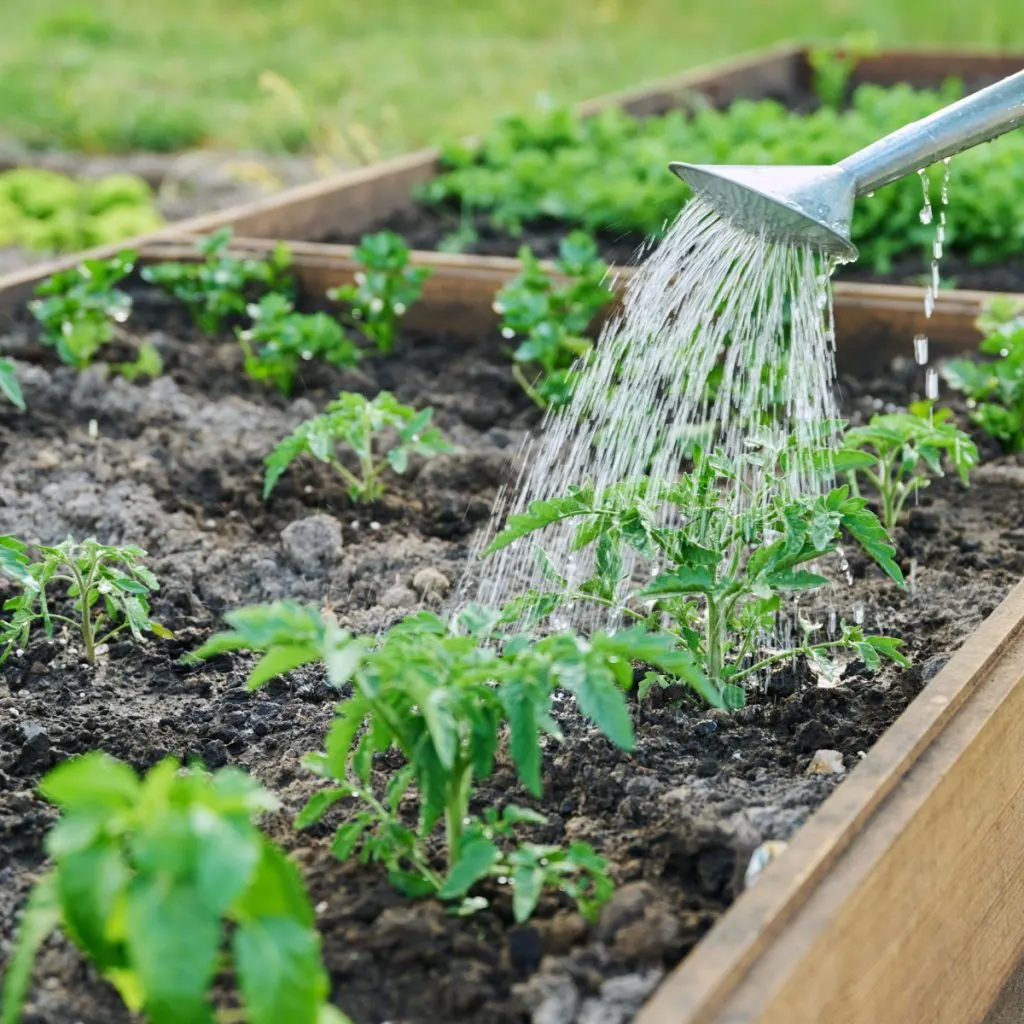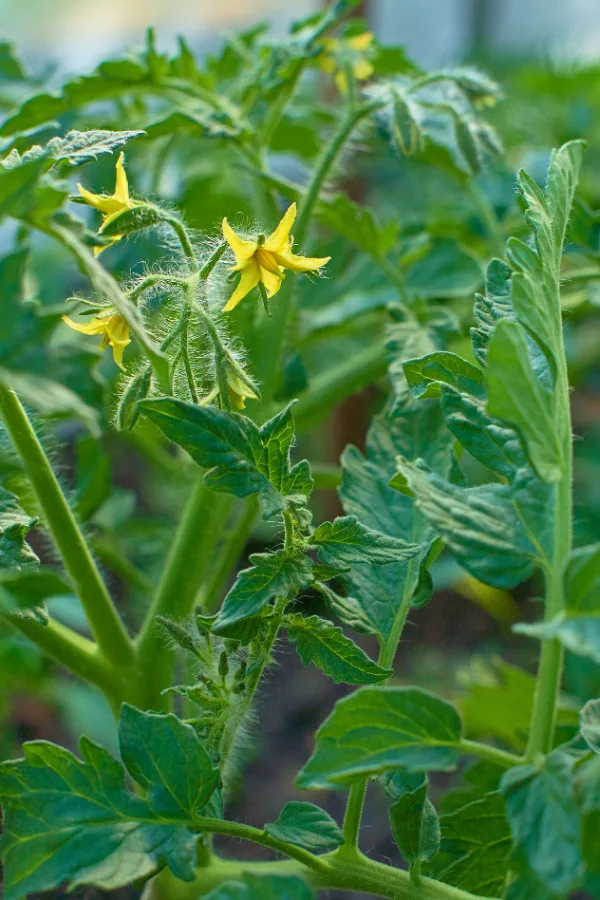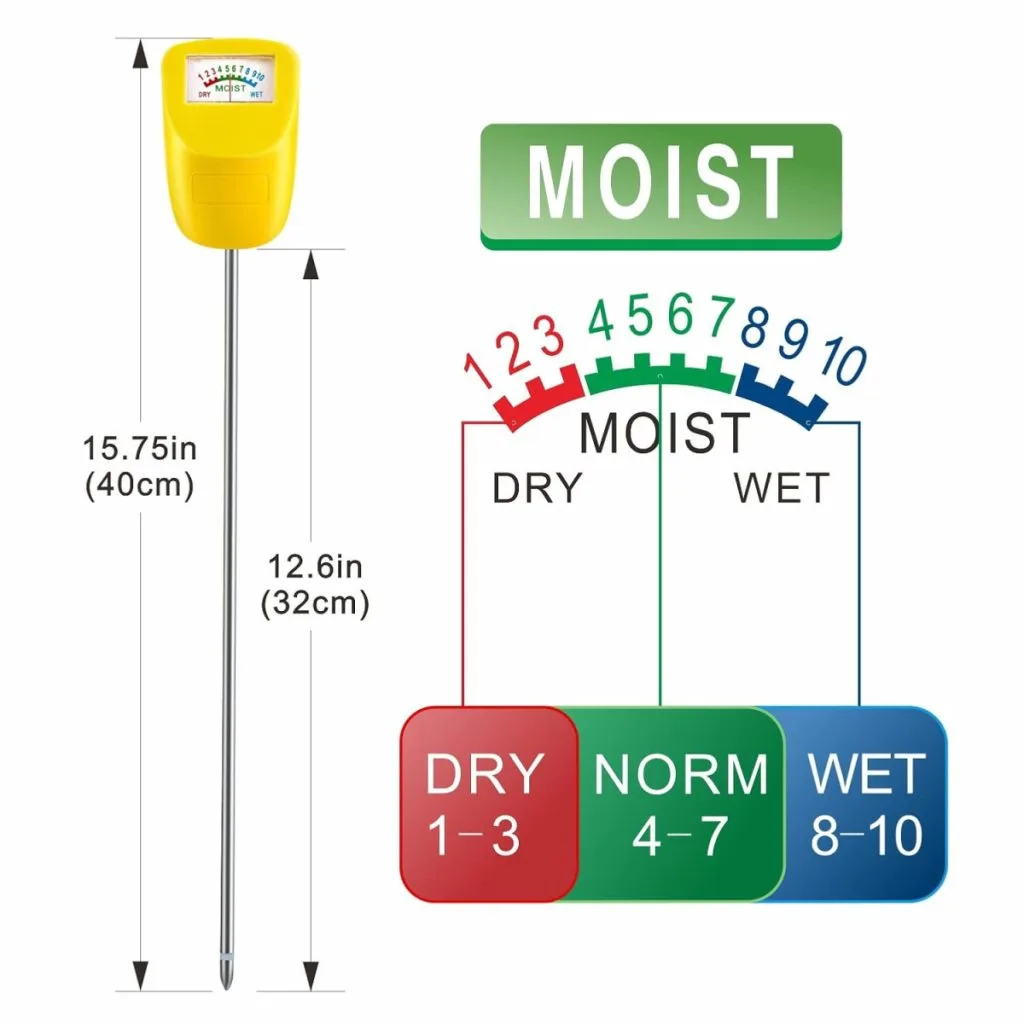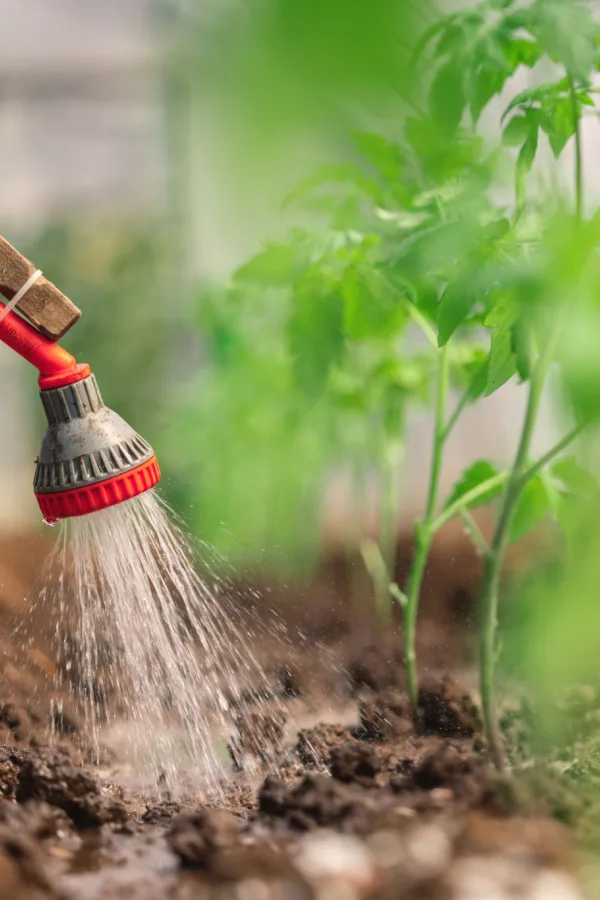Looking for the best way to water those young, newly planted tomato plants in your garden, raised beds or containers?
Watering may seem like one of the simplest gardening tasks, but when it comes to young tomato plants, it can often be one of the most misunderstood and mishandled parts of the growing process.
The simple fact is, how and when you water young tomato plants can determine just how strong, productive, and healthy they will be all season long. And in some cases – if plants even make it to summer or a harvest at all!

Unfortunately, watering issues are one of the biggest reasons tomato plants struggle. Most new gardeners assume more water is better, especially if they see leaves wilting or turning yellow. But in many cases, that extra water does more harm than good.
The Best Way To Water Young Tomato Plants
So why is watering so important? And how can you make sure you’re doing it the right way? Here is an in-depth look at what your tomato plants really need when it comes to moisture in the soil – and how to avoid the common watering mistakes that can slow down or even ruin a harvest.
Why Watering Matters So Much With Young Tomato Plants
Tomato plants need water for every stage of their growth – from establishing roots to forming blossoms and filling out fruit. Water helps carry nutrients through the plant, keeps the cells hydrated, and allows for vital functions like photosynthesis to occur.

But when watering is inconsistent or done incorrectly, all of those important functions start to break down. Young tomato plants, especially right after transplanting, are particularly sensitive to moisture levels.
Their roots are still small and shallow, and they rely heavily on the soil right around them to get their needed water. If the soil dries out too fast or stays too wet for too long, the roots can either dry up or rot out. And once a young plant starts to struggle, it has a hard time bouncing back.
The Dangers of Overwatering – The Most Common Problem When Watering Tomatoes
While it’s easy to assume that the biggest danger is not giving your plants enough water, the truth is that most tomato plants actually suffer more from being overwatered.
When the soil stays constantly saturated, tomato roots start to swell and lose their ability to take in nutrients. The plant becomes stressed. One of the first signs of this is yellowing leaves.
Unfortunately, that yellowing is often mistaken for a sign of too little water. Which is exactly why so many gardeners respond by giving the plant even more water. That, of course, only compounds the problem.

This cycle of overwatering leads to roots that can’t breathe. Tomatoes need oxygen in the root zone. If the soil is always soggy, the roots of the plant swell and become unable to take any nutrients in, When this happens, they begin to rot out.
What’s even more dangerous is that these problems aren’t always obvious at first. A plant may appear fine above the surface, but deep down, the roots are in trouble. By the time the symptoms such as stunted growth, curled leaves, or weak stems appear – the damage is already well underway.
The Right Way To Water – Deep & Less Often!
So what’s the best way to water young tomato plants? Instead of watering every day with small amounts of water, it’s much better to water every few days. But when you do – you need to water deep.
Deep watering encourages roots to grow down into the soil in search of moisture. This not only strengthens the plant but also helps it tolerate dry spells better. Shallow watering, on the other hand, keeps roots close to the surface. That makes plants more dependent on frequent watering and far less stable during hot, dry periods.
The goal is to saturate the soil down to at least 6 to 8 inches. That’s where you want the roots to grow. You can do this by watering slowly and allowing the water to soak in.

A great way to check if you’ve watered deeply enough is to use a soil moisture meter. The long probe of the meter can reach far down in the soil to give you the moisture content of the soil. Affiliate Link: Soil Moisture Meter Long Stem Deep Use
For young plants, watering every 3 to 4 days is usually ideal. That, of course, also depends on rainfall and temperature. If it’s hot and dry, you may need to water more often. If it’s cool and cloudy, you may need less. But always aim for deep, soaking waterings rather than frequent light sprays.
How Much Water Do Tomato Plants Really Need?
One of the most helpful benchmarks to use is that tomato plants need about 1 to 1.25 inches of water per week. This can come from rainfall, irrigation, or a mix of both.
It’s important to remember that this 1 to 1.25 inches is a total – not per watering. So if you water twice a week, each watering should aim to supply roughly half an inch or more, depending on recent weather and soil conditions. This is exactly where the moisture meter can help to determine if you really need to water.
Mulch Helps!
Another major key to keeping moisture levels right is using mulch. Mulching around your tomato plants helps regulate the soil temperature, reduces evaporation, and keeps the soil evenly moist. Without mulch, the top layer of soil can dry out quickly in the sun and wind.

Mulch acts like a blanket for the soil. It holds in moisture while also preventing weed growth, which can compete for the same water your tomatoes need. A four to six inch layer of straw, shredded leaves, compost, or even grass clippings can make a huge difference in how often you need to water.
It also helps prevent water runoff during heavy rains or when watering deeply. Instead of water rushing off the surface, the mulch helps slow it down so it can soak into the soil more effectively.
A Few Extra Watering Tips For Young Tomato Plants
Water early in the day – Watering in the morning gives the plant time to absorb moisture before the heat of the day. It also allows the leaves to dry off quickly, which can help reduce the risk of disease.
Avoid watering from above – Use a watering wand, drip hose, or soaker hose to deliver water directly to the soil. Wetting the foliage can increase the chances of disease, especially in humid conditions.

Watch your containers – If you’re growing tomatoes in pots or raised containers, they may need water more often. Containers dry out faster than garden soil, especially in hot weather. But still follow the deep watering rule – just check them more often.
Adjust for growth – As your tomato plants grow larger, they’ll need more water to support fruit development. Keep an eye on their size, the weather, and the soil moisture, and adjust your watering schedule accordingly. In addition to proper watering, pruning can play a key role for young tomato plants – be sure to see: Pruning Young Tomato Plants – Why You Need To Remove Early Blossoms & Fruit!
One thing is for sure – giving your young tomato plants the water they need early can set the stage for a big harvest this summer! For more on growing tomatoes, check out our article: Why To Plant Marigolds With Tomato Plants – The Big Secret To Growing Great Tomatoes.
Simple Garden Life
Follow Our Facebook Page For Even More Great Tips! Simple Garden Life Facebook Page
Simple Garden Life is a website dedicated to keeping gardening fun, simple and enjoyable! We publish two new articles each week along with a new garden podcast episode every two weeks. This article may contain affiliate links.
